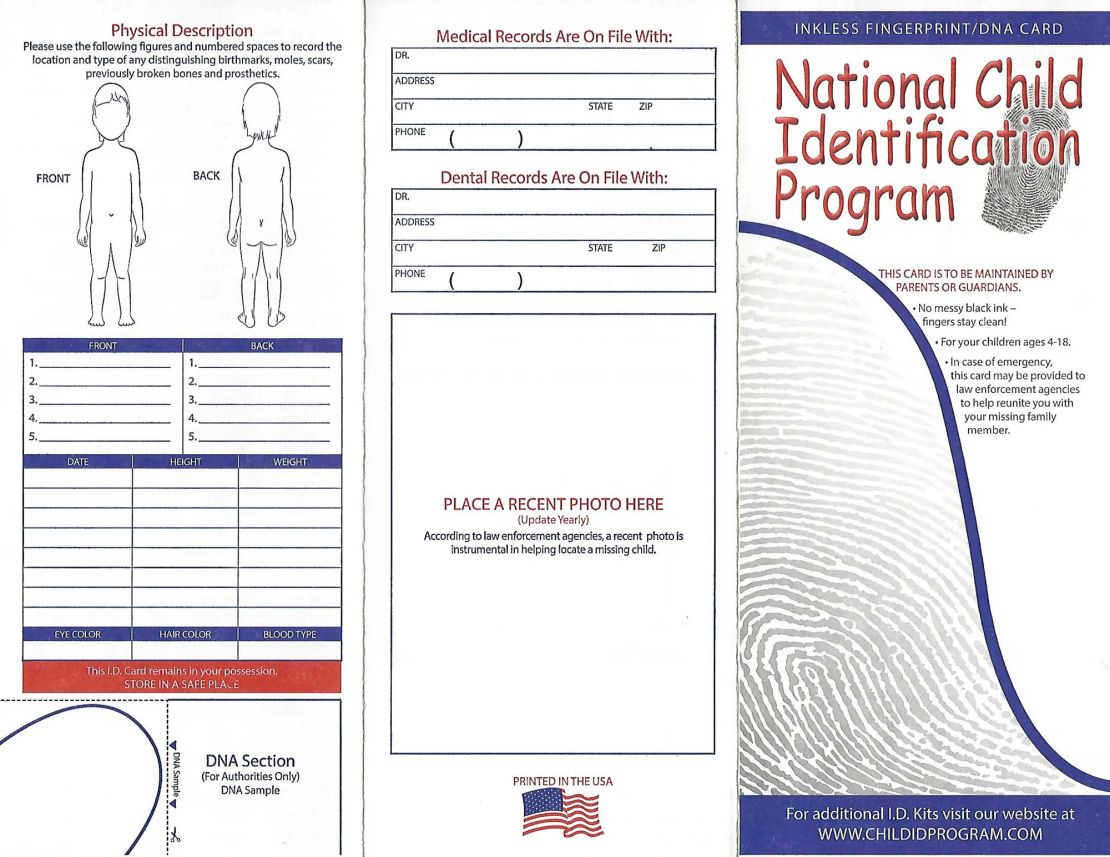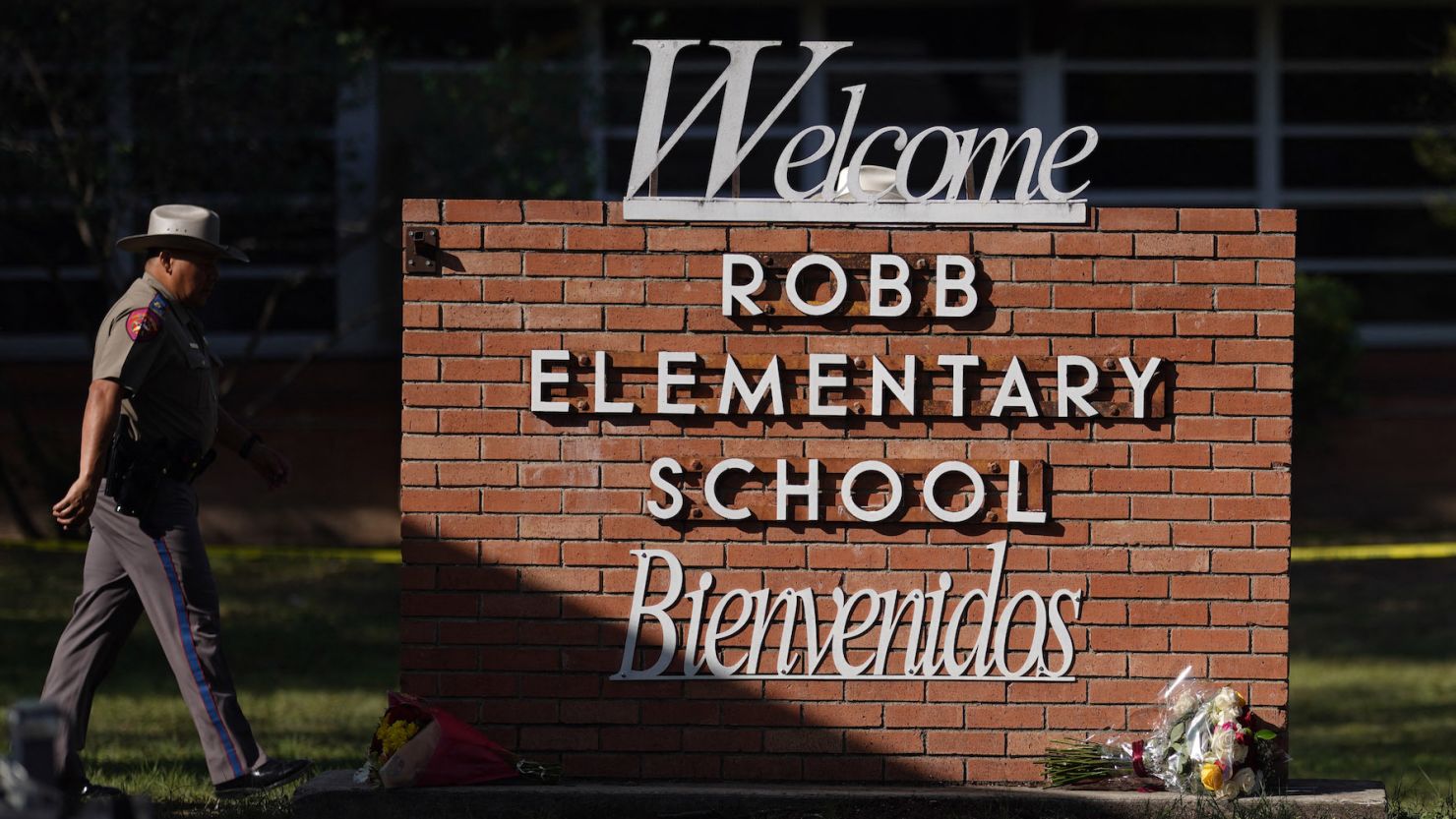A recent move by Texas school districts to provide families with child identification and DNA kits has sparked anxiety amid the horrifying backdrop that genetic material was needed by authorities to identify the fourth-grade victims killed this year in a shooting at a Uvalde elementary school.
The kits, however, are not intended for that purpose, say organizers of the program to distribute them, which passed the state legislature in 2021 – long before the massacre at Robb Elementary. And while the kits could be used after a mass casualty incident, those responsible insist the fingerprint and DNA kits, in use across the country since 1996, are actually meant to be used if a child goes missing, they told CNN.
The kits are “the gift of safety to provide parents some peace of mind” if their child is ever abducted or runs away, said Kenny Hansmire, director of the National Child Identification Program, the organization partnering with the Texas Education Agency to distribute the kits through schools across the state, as required by a new state law.
“While they can be used in the aftermath of a tragedy,” Hansmire acknowledged in a statement, “they are designed to help families and guardians prevent the fact that over 500,000 children go missing each year.”
In an email earlier this month to principals of the Houston Independent School District, Chief of Schools Denise Watts announced fingerprinting and DNA identification kits would be disseminated to elementary and middle schools beginning the week of October 17.
The email, provided to CNN by the school district, notes schools are required to inform parents and guardians the kits will “allow them to have a set of their child’s fingerprints and DNA … that they can turn over to law enforcement in case of an emergency.”
The idea behind the kits, according to the National Child Identification Program, is families can fill them out long before they’re ever needed. If a child is abducted or runs away, the kits – which are held by the parents and do not enter any type of database – families have the information ready to immediately provide to law enforcement.
Use of the kits is entirely voluntary, per a statement from the Texas Education Agency, which added – emphasis the agency’s – “And to be clear … these kits are not for identifying the victims of mass casualty incidents.”
Kits are ‘not in response to Uvalde,’ state senator says
Still, the idea Texas schools would provide families with the DNA kits drew consternation, evoking reports parents of some Uvalde shooting victims had to provide their DNA to help authorities confirm their children were among the dead.
Actor Matthew McConaughey had raised the horrific detail while speaking to reporters at the White House days after shooting in a call for gun control, saying, “Due to the exceptionally large exit wounds of an AR-15 rifle, most of the bodies so mutilated that only (a) DNA test or green Converse could identify them.”
Politicians and critics have suggested the DNA kit program’s rollout was Texas officials’ attempt to sidestep meaningful gun control reform: In response to a Houston Chronicle article about the kits, Beto O’Rourke, the Democratic candidate running against Gov. Greg Abbott, wrote on Twitter, “This is Greg Abbott’s Texas. More school shootings than any other state on his watch but no action to prevent the next.”
California Gov. Gavin Newsom, tweeting in response to the same article, similarly wrote, “Greg Abbott’s solution to gun violence? Send DNA kits to schools so parents can identify their kids’ bodies AFTER they’ve been shot and killed.”
But the office of state Sen. Donna Campbell, who sponsored the bill that led to the National Child Identification Program’s collaboration with the Texas Education Agency, said in a statement the dissemination of the kits is “not in response to Uvalde.”
“It has come to my attention that there is some confusion regarding the intent of the Child I.D. Kits currently being disseminated at schools,” Campbell said in a statement. “The Child I.D. Kits for Safe Recovery Act was passed back in 2021 to provide aid in the reunification of missing and trafficked children. My hope is that these kits provide peace of mind to parents.”
Campbell’s bill, SB 2158, introduced into the state education code a section requiring the Texas Education Agency to provide school districts with “inkless, in-home fingerprint and DNA identification kits” that could be distributed “on request to the parent or legal custodian” of any child between kindergarten and sixth grade, her office said.
The bill was introduced in April 2021 and was eventually signed into law by Abbott the following June, 11 months before the Uvalde gunman fatally shot 19 children and two teachers.
But use of the kits in Texas far predates even Campbell’s bill, per the statement from her office: The Texas Association of School Administrators first partnered with the National Child Identification Program in 2006, distributing the ID kits to Texas elementary students.
Senate Bill 2158’s intent, Campbell’s office said, was to “ensure this vital program continued in Texas.”
How the kits work
The kits are created by the National Child Identification Program, which told CNN the idea originated following the case of Amber Hagerman, a Texas 9-year-old who was abducted and murdered in 1996 and for whom the Amber Alert is named.
Over the course of the program, the initiative has partnered with numerous organizations or law enforcement agencies to disseminate the kits, often at football games; the American Football Coaches Association helped create the National Child Identification Program, per its website.
Today, the National Child Identification Program and the Safety Blitz Foundation manufacture and distribute the kits, which are funded through public-private partnerships, the ID program told CNN.
The kit itself is a three-panel paper pamphlet, which includes a form for parents or legal guardians to fill out information about their child, including their name, height and weight, race and the color of their hair and eyes. Another panel allows parents or guardians to note any distinguishing marks on their child, like scars or birthmarks, while another provides an empty space to include a photograph of the child.

On the back of the pamphlet is the fingerprint identification card, with empty boxes for the child’s fingerprints. The kit uses what the Child Identification Program describes as an inkless solution. A parent is instructed to touch their child’s finger to the solution and then to the designated box on the card.
Finally, in the bottom right-hand corner is another box for a sample of the child’s DNA. Per the pamphlet, collection just requires having the child place the corner of the pamphlet in his or her mouth and suck for one second.
Crucially, the information does not enter any sort of database, officials have said in an effort to dispel privacy concerns. Instead, families hold on to the kits until and unless their child vanishes. At that time, the kit can be handed over to law enforcement.
It’s unclear exactly how often the kits have actually been used to help reunite children with their families. In a news conference last week with Louisiana Attorney General Jeff Landry and the Louisiana Sheriff’s Association, which also is rolling out the Child ID Program, Sheriff Sid Gautreaux of Baton Rouge touted the kits’ potential benefits.
“God forbid it ever happens,” he said, but when a child vanishes, “that parent’s mind is all over the place. Emotions are all over the place.” The kits, Gautreaux told reporters, “have all the information that we need to pursue a case … And all we got to do is say, ‘Sir, ma’am, do you have a kit?’”
“It gives us everything we need to go by to start that investigation,” he said. “And time is of the essence.”
CNN’s Ashley Killough contributed to this report.



